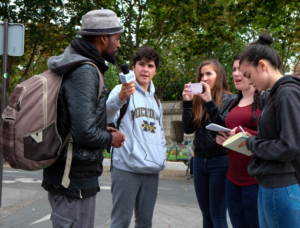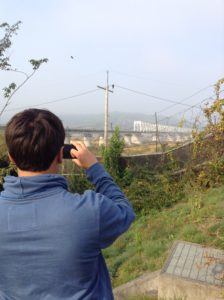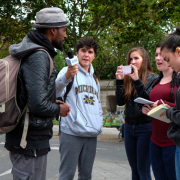Global Student Square connects student journalists from around the world

A refugee named Olaf, 26, from Somalia (far left), talks with GSS students (left to right) Louis Serra, Sloane Valen, Allegra Knox and Tailor Liedtke for a story on a refugee camp in central Paris. Photo by Andy Wiener for GSS.
Q&S Q&A with Beatrice Motamedi
Executive Director, Global Student Square
How did Global Student Square begin?
I started GSS in 2015 during a John S. Knight fellowship in journalism at Stanford. But the seed of GSS was planted a couple years earlier when I was working for a nonprofit that was trying to push journalism in low-income schools. I was meeting with a student in a school in south-central Los Angeles, and we were talking about the then-upcoming summer Olympics in Rio de Janeiro. He was an immigrant originally from Brazil, and he remarked that the stadiums that were being built for the Olympics were in out-of-the-way, rural places where nobody would ever go. And millions of dollars were going into this instead of things like housing and education, which people in cities like Rio de Janeiro and Sao Paulo desperately need. I told the student that sounded like a great story and he should write it.
“But who would publish something like that?” he asked.
For me, that was the beginning of GSS. I’m an immigrant myself so I know what it’s like to know about another country or culture or language but not really have that be part of your life. On GSS, if you know something about the world, you can tell that story.
What is the GSS mission?
Our tagline is “connect, collaborate and create” and we really mean that. We’ve just finished our second full school year so it’s still early, but we’re building our team and creating workflows, for example, on how to have global chats that work in various time zones. Our goal is more collaborative projects that bring students from different places to work together on one issue. One good example is “45 for 45,” our series of videos by teens with a message for Donald Trump (America’s 45th president). Those videos have been coming in from around the world as well as the U.S. and really showed that pretty much every problem from climate change to immigration is a global problem. Either we solve them together, or we won’t solve them at all.
Where do your stories come from?
We get stories from schools and students we work with around the world, 20 schools and 200 correspondents so far. That includes breaking news, such as the Paris climate accords, the London terror attacks and vandalism at Jewish cemeteries in the U.S., but it also includes news, features and op-eds from any of our correspondents.
Currently we have a Muslim teen columnist and a Jewish teen columnist; we have a school in Bali where students report regularly on things like marine pollution and endangered orangutans; our Korean correspondents have gone to the DMZ and covered Korean pop; and our China correspondents are doing a video a story on students stressed out by the SAT. If a story could interest a student in San Francisco and Shanghai, it’s probably a GSS story.

GSS correspondent Kiran Dwivedi takes a photo of North Korea from the South Korean side of the Demilitarized Zone (DMZ) for a story on a new train station on a line built with hopes of reunification for the two countries. Photo by Beatrice Motamedi for GSS.
What do students do?
We’re student-run, so they do a lot! Our correspondents and columnists write regularly and are on call for breaking news. Editors assign, edit, fact-check, hyperlink and publish stories and visuals. Our webmasters design things, fix things and watch analytics. Social media editors share what we do and help host global videochats (typically one per month).
We have some amazing editors, including Meghan Bobrowsky, the 2017 JEA/NSPA national high school journalist of the year; and Xavi Boluna, our webmaster, who is heading to UC Santa Cruz next fall. Our assistant webmaster, J.J. Hennessy, gave a presentation on GSS to the National Association of Media Literacy Association conference in Chicago this summer. He blew some minds — nobody could believe that a 10th grader could webmaster. But of course 10th graders can.
How do I get started?
First, look through our site. Read and watch what we’ve done so far. See how we roll — our focus is on global issues, common problems, stories that happened where you live but could be much more. Unless your story has that dimension, it won’t be for us. This year we’ll have a special emphasis on cities — the shift from rural to urban life, the push for environmental sustainability, the need for community and equity, the way immigration, law enforcement and education shape where and how we live. If you have that kind of story, we’d love to hear from you.
Second: Subscribe to our mailing list (bottom of homepage) or email your story pitch to [email protected]. An editor will respond.
Third: If you’re a student editor with at least one year of online experience, consider joining our team — apply for one of our 2017-18 internships (follow us @GSSVoices and like us on FB so you catch it). Currently we’re looking for story editors, webmasters/web designers, social media editors and a graphics editor/illustrator. We’d love to find a cartoonist! Successful applicants will have at least one-two years of experience on an online school publication, be familiar with digital media story conventions (e.g., hyperlinking, embedding video) and also use social media frequently and responsibly.
For more, email Beatrice at [email protected].
Social:
@GSSVoices on Twitter
Global Student Square on Facebook
globalstudentsquare on Instagram


Comments are closed.